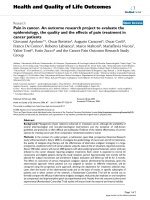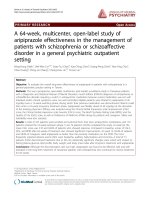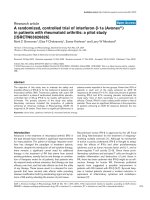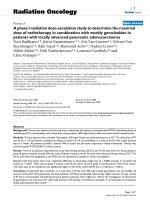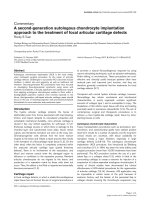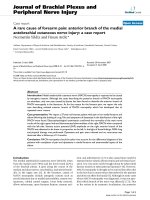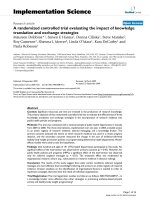Báo cáo y học: " A multi-center, randomized, double-blind, parallel, placebo-controlled trial to evaluate the efficacy, safety, and pharmacokinetics of intravenous ibuprofen for the treatment of fever in critically ill and non-critically ill adults" pdf
Bạn đang xem bản rút gọn của tài liệu. Xem và tải ngay bản đầy đủ của tài liệu tại đây (793.84 KB, 13 trang )
Morris et al. Critical Care 2010, 14:R125
/>Open Access
RESEARCH
© 2010 Morris et al.; licensee BioMed Central Ltd. This is an open access article distributed under the terms of the Creative Commons
Attribution License ( which permits unrestricted use, distribution, and reproduction in
any medium, provided the original work is properly cited.
Research
A multi-center, randomized, double-blind, parallel,
placebo-controlled trial to evaluate the efficacy,
safety, and pharmacokinetics of intravenous
ibuprofen for the treatment of fever in critically ill
and non-critically ill adults
Peter E Morris*
1
, John T Promes
2
, Kalpalatha K Guntupalli
3
, Patrick E Wright
4
and Murray M Arons
5
Abstract
Introduction: Hospitalized patients are often unable to ingest or tolerate oral antipyretics and recently an aqueous
formulation of intravenous (IV) ibuprofen was approved by the US-FDA for the reduction of fever in adults.
Methods: We evaluated IV ibuprofen to reduce fever exceeding 101.0°F, measured as the percentage of subjects
achieving a temperature <101.0°F at four hours after a single dose of IV ibuprofen vs. placebo. Secondary evaluations
included the effect on temperature at 24 hours. Nine sites randomized patients to receive either a placebo or IV
ibuprofen (100, 200, or 400 mg), and patients were given four hours for six doses. Subjects were excluded for platelet
count <30 k and/or creatinine >3.0 mg/dL.
Results: At entry, there were no significant baseline differences between the IV ibuprofen group and placebo, n = 120.
At four hours, the number (percentage) with T<101.0°F was: Placebo n = 9/28 (32%); 100 mg IV ibuprofen n = 19/31
(61%), P = 0.0264; 200 mg IV ibuprofen n = 21/30 (70%) P = 0.0043; 400 mg IV ibuprofen n = 24/31 (77%) P = 0.0005. A
total of 53/120 patients (44%) were prospectively defined as critically ill at baseline and similar temperature reductions
were observed in this subgroup. There were no statistically significant differences between treatment groups or when
compared to placebo in transfusion, bleeding, renal failure or mortality.
Conclusions: All doses of IV ibuprofen tested reduced fever at four hours and throughout the first 24 hours of dosing.
The 400 mg dose was effective in lowering temperature to normal and maintaining this over the first 24 hours of
dosing. IV ibuprofen was effective in reducing fevers in critically ill and non-critically ill groups. Following 24 hours of
administration of IV ibuprofen, no clinically significant differences in any safety parameter including renal function or
bleeding occurred through the 28-day follow-up period.
Trial registrations: Clinicaltrials.gov registration number: NCT01131000.
Introduction
Ibuprofen is a non-steroidal anti-inflammatory drug
(NSAID) that is approved as an oral treatment for mild to
moderate pain and for the reduction of fever in adults and
in children [1]. Ibuprofen was first developed as an anti-
rheumatic drug in the 1960 s [2]. Ibuprofen is believed to
work by inhibiting the formation of prostaglandins,
thereby reducing inflammation. Studies have demon-
strated the success of oral ibuprofen in the reduction of
fever as well as reduction in the subjective symptoms
associated with fever [3,4].
Oral ibuprofen is commonly used in hospitals to treat
adult patients who develop fevers during hospitalization.
However, hospitalized patients with endotracheal intuba-
tion, sedation, reduced gastric motility, nausea, recent
surgery, or other factors are frequently unable to ingest,
* Correspondence:
1
Pulmonary-Critical Care, Wake Forest University School of Medicine, Winston
Salem, NC 27157, USA
Full list of author information is available at the end of the article
Morris et al. Critical Care 2010, 14:R125
/>Page 2 of 13
Table 1: Baseline Parameters
100 mg IVIb (n = 31) 200 mg IVIb (n = 30) 400 mg IVIb (n = 31) Placebo
(n = 28)
Total
(n = 120)
N: Critically Ill 14 (45%) 12 (40%) 14 (45%) 13 (46%) 53 (44%)
N: Non-Critically Ill 17 (55%) 18 (60%) 17 (55%) 15 (54%) 67 (56%)
In ICU at BL 17 (55%) 15 (50%) 17 (55%) 16 (57%) 65 (54%)
On Mechanical Ventilation
at BL
14 (45%) 12 (40%) 14 (45%) 13 (46%) 53 (44%)
On Presssor Support at BL 2 (7%) 2 (7%) 0 (0%) 0 (0%) 4 (3%)
Age (yrs) 40.1
(± 19.0 SD)
34.5
(± 15.0 SD)
39.2
(± 17.2 SD)
37.0
(± 19.1 SD)
37.8
(± 17.5 SD)
Gender 23 M, 8 F 22 M, 8 F 22 M, 9 F 21 M, 7 F 88 M, 32 F
Race Asian 10;
Black 5;
Caucasian 13;
Hispanic: 2;
Haitian 1.
Asian 10;
Black 4;
Caucasian 15;
Hispanic 1;
Haitian 0.
Asian 10;
Black 1;
Caucasian 16;
Hispanic 4;
Haitian 0.
Asian 10;
Black 3;
Caucasian 14;
Hispanic: 1;
Haitian 0.
Asian 40;
Black 13;
Caucasian 58;
Hispanic 8;
Haitian 1.
Temperature (/°C) 39.07 ± 0.61 39.07 ± 0.71 39.16 ± 0.72 38.89 ± 0.48 N/A
Highest Temp Prior to BL
(°C)
39.4 ± 0.7 SD 39.4 ± 0.6 39.4 ± 0.7 39.2 ± 0.8 39.4 ± 0.7
Heart Rate (bpm) 106.0 ± 20.4 105.4 ± 18.4 102.7 ± 18.4 102.9 ± 15.4 104.3 ± 18.1
Mean Arterial Pressure 81.7 ± 12.9 83.3 ± 11.7 87.8 ± 12.7 88.1 ± 15.6 85.2 ± 13.4
Height
(cm)
170.3 ± 10.3 170.1 ± 10.5 168.2 ± 10.1 168.8 ± 11.8 169.4 (±10.6 SD)
Weight
(kg)
77.9 ± 32.6 80.3 ± 29.2 72.5 ± 23.4 78.4 ± 26.6 77.2 (± 28.0)
Positive Blood Culture 13 (42%)
(8 ± Malaria)
13 (43%)
(10 ± Malaria)
12 (39%)
9 ± Malaria
13 (46%)
10 ± Malaria
51 (43%)
37 ± Malaria
Modified APACHE II 11.4
(± 7.6 SD)
12.0
(± 7.7 SD)
13.4
(± 7.8 SD)
12.5
(± 9.7 SD)
12.3
(± 8.1 SD)
Glasgow Coma Score 3 to 8: 4 (13%)
9 to 12: 3 (10%)
>13:24 (77%)
3 to 8: 6 (20%)
9 to 12: 3 (10%)
>13:21 (70%)
3 to 8: 7 (23%)
9 to 12: 4 (13%)
>13:20 (65%)
3 to 8: 5 (18%)
9 to 12: 3 (11%)
>13:20 (71%)
3 to 8: 22 (18%)
9 to 12: 13 (11%)
>13:85 (71%)
Emerg. PostOp
Elect Post Op
Non Operative
2 (6%)
0 (0%)
29 (94%)
4 (13%)
0 (%)
26 (87%)
2 (6%)
3 (10%)
26 (84%)
1 (4%)
0 (0%)
27 (96%)
9 (%)
3 (%)
108 (%)
Chronic Conditions
(from Modified APACHE II)
Liver 0(0%)
CV 0 (0%)
Resp 1(3%)
Renal 0(0%)
Immun 2(6%)
None 28(90%)
Liver 0(0%)
CV 0 (0%)
Resp 1(3%)
Renal 0 (0%)
Immun 2(7%)
None 27(90%)
Liver 0 (0%)
CV 0 (0%)
Resp 1(3%)
Renal 0 (0%)
Immun1(3%)
None 29 (94%)
Liver 0 (0%)
CV 0 (0%)
Resp 1 (4%)
Renal 0 (0%)
Immun (7%)
None 25 (9%)
Liver 0 0%)
CV 0 (0%)
Resp 4(3%)
Renal 0 (0%)
Immun 7(6%)
None109 (91%)
WBC 11.6 ± 7.2 10.9 ± 6.6 9.6 ± 5.0 11.6 ± 6.4 10.9 ± 6.3
Creatinine (mg/dL) 0.95 ± 0.26 .97 ± 0.25 0.97 ± 0.35 1.0 ± 0.44 0.97 (±0.33)
Hematocrit
(%)
36.8 ± 7.7 34.1 ± 6.5 33.7 ± 6.0 34.5 ± 6.9 34.8 ± 6.8
Hemoglobin (g/dL) 12.3 ± 2.5 11.4 ± 2.2 11.4 ± 2.1 11.6 ± 2.3 11.7 ± 2.3
Platelet Count 221.6
(± 158.7)
189.7
(± 111.3)
173.6
(±116.3)
220.0
(±123.61)
200.9
(± 129.1)
Probable Site Infection None 1(3%);
Blood 9 (29%);
Lung 9 (29%);
Abdom 2 (6%)
Other 3 (10%)
CNS 2 (6%)
Urine Tr 0 (0%)
Skin/Tis 2 (6%)
Up Resp 2(6%)
GYN 0 (0%)
IV 1(3%)
Unk 2(6%)
None (3%)
Blood 10 (33%)
Lung 7 (23%)
Abdom 4 (13%)
Other 3 (10%)
CNS 3 (10%)
Urine Tr 0(0%)
Skin/Tis1 (3%)
Up Resp 0(0%)
GYN 0 (0%)
IV 0 (0%)
Unk 1 (3%)
None 2 (6%)
Blood 10 (32%)
Lung 9 (29%)
Abdom 1 (3%)
Other 4 (13%)
CNS 1 (3%)
Urine Tr 3 (10%)
Skin/Tis 0 (0%)
Up Resp1 (3%)
GYN 0(0%)
IV 0(0%)
Unk 0(0%)
None 2 (7%)
Blood 11 (39%)
Lung 5 (18%)
Abdom 4 (14%)
Other 1 (4%)
CNS 0 (0%)
Urine Tr 2 (7%)
Skin/Tis1(4%)
Up Resp 0 (0%)
GYN 1 (4%)
IV 0(0%)
Unk 1(4%)
None 6(5%)
Blood 40 (33%)
Lung 30 (25%)
Abdom 11 (9%)
Other 11 (9%)
CNS 6(5%)
Urine Tr 5 (4%)
Skin/Tis 4 (3%)
Up Resp 3 (3%)
GYN (1%)
IV 1(1%)
Unk 2(2%)
BL, Baseline.
Morris et al. Critical Care 2010, 14:R125
/>Page 3 of 13
digest, absorb, or tolerate oral antipyretics. However, the
US-FDA recently approved an aqueous formulation of IV
ibuprofen for the reduction of fever in adults (Cumber-
land Pharmaceuticals, Inc., Nashville, TN, USA) to
address this unmet medical need. The current study was
designed to evaluate the efficacy of IV ibuprofen in
patients with fever greater than or equal to 101.0°F com-
pared to placebo.
Materials and methods
This multicenter, randomized, double-blind, parallel, pla-
cebo-controlled clinical study was designed to assess the
efficacy, safety, and pharmacokinetics of IV ibuprofen in
adult subjects with fevers greater than or equal to 101.0°F.
Subjects were randomized to receive a placebo or one of
three doses of IV ibuprofen (100 mg, 200 mg, or 400 mg),
so that each of the four treatment groups would consist of
approximately 30 subjects. Randomization was per-
formed by site and was stratified on the basis of the sever-
ity of the patient's condition. Randomization envelopes
were provided to each site and were opened by the phar-
macist in sequential order. At the time of randomization,
at least 33% of the patients randomized were to be criti-
cally ill (in the hospital requiring mechanical ventilation
for respiratory failure, pressor support for hypotension,
or both), and at least 33% were to be not critically ill. Par-
ticipants were assigned to treatment using a permuted
block randomization scheme. A unique treatment num-
ber coupled to one of three active doses or placebo ther-
apy was assigned to each study participant. Within any
given center, treatment numbers were assigned sequen-
tially to participants in the order they were enrolled,
based upon stratification. The randomization block size
was four. The randomization block size was not revealed
during the course of the study to assist in maintaining the
blind. The study was double-blind with respect to the
treatment assignment. The patient, Investigator, and
sponsor were blinded to the assigned treatment until all
patients had completed the protocol and after the study
database had been analyzed. Randomization codes were
generated using a pseudo-random number generator and
stickers for randomization envelopes were generated
automatically. Each subject was assigned a unique treat-
ment number linked to the assigned treatment number of
the master randomization list. After opening the ran-
domization envelope, provided to each site, the study site
pharmacist or pharmacy technician prepared each
patient's doses of IV ibuprofen or placebo and provided
these to the Investigator in identical infusion bags labeled
with the patient's identification number. Patients were
enrolled from sites in North America, Thailand and Aus-
tralia, between 2002 and 2005. Study material or placebo
was administered in a 100 mL bag of normal saline. Addi-
tion of IV ibuprofen to the bag for dilution did not notice-
ably affect the volume of the infusion bag, since only a
maximum of 4 mL was added. However, pharmacists
were instructed to puncture the port of the placebo/nor-
mal saline infusion bag such that upon inspection it
would appear identical to a bag prepared with IV ibupro-
fen.
Hospitalized patients were included if: fever developed
within previous seven days, was documented by tempera-
ture >/= 101.0°F, and have IV access. Exclusions were:
baseline platelet count was less than 30,000/mm
3
; base-
line creatinine was greater than 3.0 mg/dL; <18 years old,
received antipyretic drugs <4-hrs of dosing; allergy to IV
ibuprofen, NSAIDs, or COX-2 inhibitors; pregnancy; his-
tory of head trauma requiring hospitalization, intracra-
nial surgery or stroke within 30 days or history of
arteriovenous malformation, cerebral aneurysm or cen-
tral nervous system mass lesion; weighed <40 kg; history
of bleeding diatheses, history of gastrointestinal bleeding
that required medical intervention less than six weeks
unless definitive surgery had been performed; required
full anticoagulation or therapy with activated protein c
within six hours of dosing; fever secondary to drug reac-
tion; expected life span <14 days; required treatment with
corticosteroids; neurogenic fever; required dialysis or
received nephrotoxic drugs; major surgery <12 hours of
dosing unless adequate hemostasis had been achieved.
The preferred method of temperature measurement was
core. If a non-core route was used, temperature measure-
ment was to be verified by an additional route of mea-
Table 2: Ventilation and length of hospital stay
Placebo 100 mg 200 mg 400 mg
Critically ill patients
# patients 13 14 12 14
Mechanical ventilation
median days 14 14 11 11
ICU length of stay
median days 18 14 15 12
Hospital length of stay
median days 18 35 25 20
Non-critically ill
patients
# patients 15 17 18 17
Hospital length of stay
median days 29 14 23 29
Morris et al. Critical Care 2010, 14:R125
/>Page 4 of 13
surement; the route of temperature measurement used
immediately before randomization was to be the same
immediately before dosing and for all temperature mea-
surements during the treatment period. Treatment con-
sisted of one dose of study drug every four hours, for a
total of six doses. Assessments of temperature, vital signs,
laboratory measurements, and safety monitoring were
performed from baseline through Hour 120. Patients'
hospital course was followed throughout remainder of
hospitalization through Day 28 for the occurrence of seri-
ous adverse events. An equal volume of normal saline was
used as placebo. The primary efficacy variable was based
on the reduction in the percentage of patients with a body
temperature of <101.0°F at four hours post initiation of
the first dose of study drug. Safety assessments included
vital signs, chemistry and hematology results, transfusion
requirements and monitoring for adverse events. Blood
samples were required by protocol to be collected at
baseline and specific post-dosing times during the study
from the first 98 subjects to measure IV ibuprofen phar-
macokinetics.
The study protocol was approved by an appropriate
Independent Ethics Committee (IEC) or Institutional
Review Board (IRB) at each clinical study site. Consent
was obtained from the patient or IRB-approved desig-
nated surrogate. This multi-center study was sponsored
by Cumberland Pharmaceuticals Inc. (CPI). The authors
had access to all data and prepared the manuscript. A
data safety monitoring board (DSMB) reviewed serious
adverse events and study results as they related to safety
and quality.
Rescue treatment for persistent fever
Rescue treatment was available to subjects who met
treatment failure criteria. Treatment failure was a tem-
perature of >/= 103.0°F during Treatment Period after a
minimum of two hours post study drug or placebo. The
Investigator decided whether to administer rescue treat-
ment. Rescue treatments included acetaminophen, cold
packs, cooling blankets, alcohol baths or other treatments
designated by the physician, excluding aspirin or
NSAID's. Delivery of study drug or placebo was discon-
tinued for any patient receiving rescue treatment.
For randomized subjects to be given the first dose of
study drug, they must have remained febrile to within 15
minutes prior to dosing of study drug.
Figure 1 Temperature (°F) by treatment, ITT population. ITT, intention to treat; IVIb, intravenous ibuprofen.
IND 62,605 Protocol No. CPI-CL-004
97.5
98.0
98.5
99.0
99.5
100.0
100.5
101.0
101.5
102.0
102.5
103.0
0 4 8 12162024
Time Since First Dose (h)
Average Temperature (°Fahrenheit)
100 mg IVIb
(n=31)
200 mg IVIb
(n=30)
400 mg IVIb
(n=31)
Placebo
(n=28)
101.0 degrees F
Morris et al. Critical Care 2010, 14:R125
/>Page 5 of 13
Statistical analysis
Data from a published study of intravenous ibuprofen in
sepsis subjects were used to provide information about
treatment differences in subjects treated with 800 mg
intravenous ibuprofen or placebo [5]. At four hours after
administration of the first dose, 78.2% of the subjects who
received intravenous ibuprofen and 41.8% of the subjects
who received placebo had temperatures below 101.0°F
(38.3°C). On the basis of these data, a sample size of 30
subjects per treatment group in the ITT analysis would
provide 80% power for a χ
2
test, at the significance level of
= 0.05, to detect this same treatment difference approx-
imately 37%).
The data demonstrated are for the Intention to Treat
population (ITT). Continuous data were summarized by
mean and standard deviation or standard error. Categori-
cal data were summarized by frequency and the percent-
age of subjects in each treatment group. All statistical
tests were two-sided, with P-values less than 0.05 for
treatment differences to be considered significant. The
primary endpoint was analyzed by using the Cochran-
Mantel-Haenszel (CMH) procedure adjusted for center.
An analysis of variance (ANOVA) model was used to
compare differences between treatment groups in the
area under the temperature versus time curve (AUC-T°)
in the first 24 hours, when the AUC-T° calculated was the
difference between the measured temperature at a given
time point and a target (normal) temperature of 98.6°F.
On the basis of plasma ibuprofen concentration-time
data, pharmacokinetic parameters were assessed by using
a non-compartmental model. Area under the concentra-
tion-time curve from Hour 0 to Hour 4 (AUC
0 to 4
), was
calculated by using the linear-log trapezoidal rule: linear
trapezoidal rule up to time to maximum concentration,
and then a log trapezoidal rule for the remainder of the
curve, where the last measurable time is at Hour 4.
All statistical computations were performed using
SAS
®
.
Results
Between June 2002 and August 2005, 4,465 patients were
screened at 10 clinical centers, 120 of whom were
enrolled in the study. Patients screened but not enrolled
either met exclusion criteria or became afebrile prior to
administration of the first scheduled dose of study medi-
cation. These 120 subjects were randomized into four
treatment groups: 100 mg IV ibuprofen (n = 31); 200 mg
IV ibuprofen (n = 30); 400 mg IV ibuprofen (n = 31) and
Figure 2 Temperature over time, critically ill.
97.5
98.0
98.5
99.0
99.5
100.0
100.5
101.0
101.5
102.0
102.5
103.0
0 4 8 12162024
Time Since First Dose (h)
Average Temperature (°Fahrenheit)
Critically Ill, 100 mg IVIb
(n=14)
Critically Ill, 200 mg IVIb
(n=12)
Critically Ill, 400 mg IVIb
(n=14)
Critically Ill, Placebo
(n=13)
101.0 degrees F
Morris et al. Critical Care 2010, 14:R125
/>Page 6 of 13
placebo (n = 28). A total of 53 (44%) of subjects met criti-
cally ill criteria at randomization and 67 (56%) were non-
critically ill. Overall, 65% of patients were enrolled from
sites in the United States, 33% from Thailand and 2%
from Australia, Table 1. Critically ill subjects were
enrolled exclusively from US sites. Table 1 demonstrates
baseline data. There were no differences among the four
arms of the study in baseline demographics. Also, analy-
ses of baseline data compared critically ill and non-criti-
cally ill populations and combined IV ibuprofen
treatment groups versus placebo, and there were no sta-
tistically significant differences between the critically ill
versus critically ill-placebo, non-critically ill versus non-
critically ill placebo or the combined IV ibuprofen group
versus the placebo group, Table 1. There were no differ-
ences in mean age, Acute Physiology and Chronic Health
Evaluation II (APACHE II), or site of infection. No differ-
ences were found across critically ill groups for days of
mechanical ventilation, ICU days or hospital days. Simi-
larly, no differences were found across non-critically ill
groups for hospital days, Table 2.
In the Intention to Treat (ITT) population, fever at four
hours in the 400 mg IV ibuprofen group (primary end-
point) showed 24 of 31 (77%) of subjects, compared to 9
of 28 (32%) of the placebo group with a temperature
<101.0°F, P = 0.0005. For secondary endpoints, 21 of 30
(70%) of subjects in the 200 mg IV ibuprofen group, and
19 of 31 (61%) of subjects in the 100 mg IV ibuprofen
group, compared to 9 of 28 (32%) of the placebo group
had a temperature <101.0°F, P = 0.0264. Figure 1 demon-
strates the mean temperatures of study subjects by proto-
col arm in the first 24 hours. Decrements in temperature
were observed in both the critically ill subjects receiving
IV ibuprofen vs. critically ill subjects receiving placebo
and in the non-critically ill subjects receiving IV ibupro-
fen vs. non-critically ill subjects receiving placebo, Fig-
ures 2 and 3, respectively.
Table 3: Area under the curve (AUC 0-4) for plasma ibuprofen concentrations
Average of treatment Group 100 mg IV Ibuprofen 200 mg IV Ibuprofen 400 mg IV Ibuprofen
AUC0-4 (μg.h/mL) 22.33 +/- 12.75 (SD) 32.62 +/- 17.39 (SD) 70.64 +/- 31.93 (SD)
Figure 3 Temperature over time, non-critically ill.
97.5
98.0
98.5
99.0
99.5
100.0
100.5
101.0
101.5
102.0
102.5
103.0
0 4 8 12162024
Time Since First Dose (h)
Average Temperature (°Fahrenheit)
Non-Critically Ill, 100 mg IVIb
(n=17)
Non-Critically Ill, 200 mg IVIb
(n=18)
Non-Critically Ill, 400 mg IVIb
(n=17)
Non-Critically Ill, Placebo
(n=15)
101.0 degrees F
Morris et al. Critical Care 2010, 14:R125
/>Page 7 of 13
In a secondary analysis of efficacy, the efficacy of IV
ibuprofen was analyzed by assessing the percentage of
treatment failures compared to placebo. In the ITT popu-
lation at 24 hours, the mean time to treatment failure in
hours was: Placebo 5.70 +/- 1.97; 100 mg IV ibuprofen,
7.39 +/- 1.39, P = 0.75 compared to placebo; 200 mg IV
ibuprofen, 10.29 +/- 3.25, P = 0.22 compared to placebo;
400 mg IV ibuprofen, 10.75 +/- 2.75, P = 0.39 compared
to placebo.
In the ITT by 24 hours, the mean temperature decrease
from baseline was: Placebo 2.07°F +/- 2.37; 100 mg IV
ibuprofen, 3.07°F +/- 1.95°F with a mean difference of
1.0°F (-4.77 to 6.75, 95% CI); 200 mg IV ibuprofen, 3.12°F
+/- 1.88°F with a mean difference of 4.40°F (-1.40 to
10.21, 95% CI); 400 mg IV ibuprofen, 3.45°F +/- 2.02 with
a mean difference of 1.37°F (-4.39 to 7.13, 95% CI). The
area under the temperature versus time curve (AUC-T)
was calculated for 0 to 24 hours, for temperature above
98.4°F. For the ITT, comparison of treatment group
against placebo showed that AUC-T over 24 hours was
significantly less for all active treatment groups compared
to the placebo group, with average reductions of 15.30°F
Table 4: Adverse events and serious adverse events
Number of subjects (% of treatment group) 100 mg IV
Ibuprofen
200 mg IV
Ibuprofen
400 mg IV
Ibuprofen
Placebo
Subjects experiencing no AEs 4 13% 5 17% 8 26% 3 11
%
Subjects experiencing any AEs (including SAEs) 27 87% 25 83% 23 74% 25 89
%
Subjects experiencing SAEs (including death) 6 19% 5 17% 4 13% 4 14
%
Patient deaths 1 3% 2 7% 2 6% 1 4%
Total subjects 31 30 31 28
Figure 4 Mean ibuprofen concentrations (hour 0 to 4), by treatment group and randomization stratum.
Morris et al. Critical Care 2010, 14:R125
/>Page 8 of 13
Table 5: Creatinine values over time with actual and percent change from baseline by treatment
Creatinine (mg/dL) Lab values over time Change from baseline (actual and percent)
Baseline Hour 24 Hour 72 Hour 120 to Hour 24 to Hour 72 to Hour 120
100 mg IV Ibuprofen Average 0.95 0.85 0.85 0.87 009 -6.4% -0.09 -4.1% -0.08 -1.9%
SD 0.26 0.21 0.21 0.30 0.23 25.6 0.33 37.0 0.40 48.7
N 31 30 29 28 3030292928 28
Min 0.57 0.50 0.50 0.50 -0.60 -44.4% -0.80 -50.0% -0.90 -56.3%
Max 1.60 1.40 1.70 2.20 0.50 71.4% 1.00 142.9% 1.50 214.3%
200 mg IV Ibuprofen Average 0.97 0.85 0.90 0.83 -0.12 -11.4% -0.07 -6.0% -0.08 -7.5%
SD 0.25 0.28 0.29 0.19 0.20 18.3 0.23 19.5 0.17 18.7
N 30 30 27 24 3030272724 24
Min 0.60 0.11 0.50 0.50 -0.97 -89.8% -0.60 -37.5% -0.40 -28.6%
Max 1.60 1.50 1.70 1.30 0.20 15.4% 0.50 41.7% 0.30 50.0%
400 mg IV Ibuprofen Average 0.97 0.97 1.07 1.05 0.00 -2.8% 0.11 6.7% 0.06 5.8%
SD 0.35 0.59 1.05 0.93 0.37 31.7 0.93 88.7 0.86 84.5
N 31 30 31 27 3030313127 27
Min 0.40 0.30 0.30 0.30 -0.31 -34.1% -0.30 -30.0% -0.40 -33.3%
Max 2.10 3.20 5.81 5.28 1.39 136.3% 4.79 469.6% 4.26 417.6%
Placebo Average 1.00 0.94 0.86 0.87 -0.06 -5.4% -0.14 -10.3% -0.16 -9.8%
SD 0.44 0.40 0.25 0.23 0.13 12.4 0.26 15.5 0.34 20.4
N 28 28 28 24 2828282824 24
Min 0.60 0.42 0.50 0.50 -0.30 -33.3% -1.10 -46.7% -1.30 -53.3%
Max 2.80 2.50 1.70 1.50 0.20 18.2% 0.20 25.0% 0.30 37.5%
Morris et al. Critical Care 2010, 14:R125
/>Page 9 of 13
Table 6: Hemoglobin values over time with actual and percent change from baseline by treatment
Hgb (g/dL) Lab values over time Change from baseline (actual and percent)
Baseline Hour 24 Hour 72 Hour 120 to Hour 24 to Hour 72 to Hour 120
100 mg IV Ibuprofen Average 12.3 11.2 11.2 11.0 -1.1 -8.8% -1.3 -8.2% -1.3 -8.8%
SD 2.5 2.1 1.6 1.8 1.0 7.3 2.0 15.3 2.0 15.9
N 31 30 28 27 303028282727
Min 8.2 6.4 8.2 7.2 -4.0 -23.1% -6.4 -37.0% -7.1 -47.0%
Max 17.3 15.1 15.3 14.9 0.6 4.6% 3.4 35.1% 3.1 37.8%
200 mg IV Ibuprofen Average 11.4 10.4 10.4 10.5 -1.0 -8.5% -1.0 -7.9% -0.8 -5.5%
SD 2.2 2.0 1.8 2.0 1.0 8.1 1.3 10.4 1.4 13.2
N 30 30 26 24 303026262424
Min 7.2 6.0 6.5 6.3 -3.3 -22.7% -4.3 -28.9% -3.4 -24.1%
Max 15.2 14.0 14.6 14.4 0.6 6.2% 1.1 12.7% 2.3 25.3%
400 mg IV Ibuprofen Average 11.4 10.3 10.2 10.4 -1.1 -8.9% -1.2 -9.6% -0.8 -5.3%
SD 2.1 1.7 1.8 1.2 1.0 8.5 1.5 12.9 1.7 14.4
N 31 30 31 27 303031312727
Min 7.9 7.2 5.6 8.2 -2.8 -22.6% -4.1 -39.8% -4.2 -28.0%
Max 16.2 14.7 13.2 13.0 1.3 15.3% 2.0 25.0% 2.5 31.3%
Placebo Average 11.6 10.7 10.4 10.4 -0.9 -6.9% -1.3 -9.6% -1.3 -9.1%
SD 2.3 1.9 1.7 1.7 1.2 12.4 1.5 13.8 1.7 17.8
N 28 28 27 24 282827272424
Min 6.0 7.6 7.6 8.1 -3.0 -26.9% -3.7 -27.8% -4.4 -33.1%
Max 16.2 14.6 13.3 13.8 2.5 41.7% 1.7 28.3% 3.1 51.7%
Morris et al. Critical Care 2010, 14:R125
/>Page 10 of 13
Table 7: Platelet values over time with actual and percent change from baseline by treatment
Platelets (×10
9
/L)
Lab values over time Change from baseline (actual and percent)
Baseline Hour 24 Hour 72 Hour 120 to Hour 24 to Hour 72 to Hour 120
100 mg IV Ibuprofen Average 222 210 270 325 -14 -7% 40 41% 112 109%
SD 159 164 157 191 43 17 92 69 145 140
N 31 30 28 27 303028282727
Min 41 36 73 39 -99 -41% -191 -38% -169 -77%
Max 659 756 690 933 103 20% 230 269% 473 513%
200 mg IV Ibuprofen Average 190 201 293 416 11 7% 101 82% 228 188%
SD 111 127 190 239 63 27 148 99 194 180
N 30 30 26 24 303026262424
Min 35 29 102 148 -197 -56% -200 -57% 3 2%
Max 477 492 965 1258 205 71% 678 412% 971 686%
400 mg IV Ibuprofen Average 174 162 229 308 -9 -6% 55 54% 136 156%
SD 116 110 126 149 36 23 103 69 168 161
N 31 30 31 27 303031312727
Min 34 20 39 117 -87 -49% -209 -41% -301 -58%
Max 516 464 562 866 115 64% 367 243% 685 533%
Placebo Average 220 213 268 339 -7 -4% 43 32% 127 98%
SD 124 136 137 137 61 28 84 56 114 122
N 28 28 27 24 282827272424
Min 48 5 22 61 -163 -97% -192 -87% -162 -64%
Max 541 448 502 594 130 44% 178 213% 301 521%
Morris et al. Critical Care 2010, 14:R125
/>Page 11 of 13
deg*h (100 mg IV ibuprofen), 21.46°F deg*h (200 mg IV
ibuprofen) and 28.97°F deg*h (400 mg IV ibuprofen).
The pharmacokinetics of IV ibuprofen were deter-
mined. The AUC
0-4
was approximately dose proportional
for the 200 mg and 400 mg dose levels of IV Ibuprofen,
see Table 3.
Figure 4 demonstrates the mean plasma concentrations
of ibuprofen for each of the three drug dosage arms in
both the critically ill and non-critically ill populations.
There is a numerically lower concentration within the
critically ill population at each dose compared to the
same dose delivered to the non-critically ill population.
Interestingly, decrements in temperature within the criti-
cally ill were less for each dose as compared to the decre-
ments in fever for the non-critically ill population
(Figures 2 and 3, respectively).
Safety
Exposure to the study drug among the 120 subjects
included: 27 of the 31 subjects (87%) in the 100 mg IV
ibuprofen treatment group received all six doses of the
study drug, all 30 subjects (100%) in the 200 mg IV ibu-
profen treatment group received all six doses of the study
drug, 28 of the 31 subjects (90%) in the 400 mg IV ibupro-
fen treatment group received all six doses of the study
drug, and 23 of the 28 (82%) in the placebo group
received all six doses of the placebo.
There were no differences in serious adverse events
(SAEs) or adverse events (AEs) between subjects treated
with IV ibuprofen and placebo, particularly in regards to
bleeding or renal failure, except for bacteremia. There
were four patients post-enrollment in the 100 mg IV ibu-
profen and one patient in the 200 mg IV ibuprofen groups
with bacteremia; no bacteremia was reported in the 400
mg IV or placebo groups (P = 0.045). Site investigators
reported these bacteremias as consistent with underlying
disease and not related to study drug. There were 17 sub-
jects for whom 29 SAEs were reported: 100 mg IV ibu-
profen six subjects (five critically ill subjects, one non-
critically ill); 200 mg IV ibuprofen five subjects (four crit-
ically ill, one non-critically ill); 400 mg IV ibuprofen three
subjects (two critically ill, one non-critically ill) and pla-
cebo three (two critically ill, one non-critically ill), Table
4. Of the 29 events, none were felt by the site investigator
to be related to the study drug. Choices of relationship to
study material could have been coded as related, not
related and unknown/uncertain. Of the 29 events, none
were coded as related; 24 were coded as not related; and 5
as unknown/uncertain (serious AE's 100 mg IVIb three;
400 mg IVIb one and placebo one). Those five events
were: dilated and fixed right pupil, punctuate intraparen-
chymal hemorrhage, left humerus fracture, multi-system
organ failure secondary to sepsis, bilateral tension pneu-
mothorax. There were no statistically significant differ-
ences between treatment groups with regards to the
requirements for transfusion of red cell units (100 mg IV
ibuprofen five; 200 mg IV ibuprofen three; 400 mg IV ibu-
profen five and placebo four). There were no patient
deaths during the 24-hour study treatment period. Six
subjects participating in this study (5%) died during the
28-day study observation period from conditions related
to their critical medical condition at the time of enroll-
ment in the study.
The laboratory parameters with the most subjects
experiencing changes from not clinically significant
(NCS) at baseline to clinically significant (CS) at 24 hours
post-dose were: potassium (8 subjects), albumin (8 sub-
jects), protein (9 subjects), LDH (6 subjects); hemoglobin
(10 subjects), eosinophils (12 subjects), WBC (6 subjects),
HCT (6 subjects), platelets (5 subjects), monocytes (4
subjects), lymphocytes (6 subjects) and PMN's + bands (5
subjects). There was no effect related to treatment. There
were no subjects who experienced renal complications or
a rise in creatinine, a change in hemoglobin related to IV
ibuprofen, and no subjects experienced a change in plate-
let count that was thought to be related to IV ibuprofen,
Tables 5, 6 and 7.
Discussion
In this population of hospitalized patients a significantly
greater proportion of subjects experienced a lowering of
their temperature to less than 101°F within four hours
after one dose of 400 mg of IV ibuprofen as compared to
those receiving the placebo, demonstrating the efficacy of
IV ibuprofen to control fever in both acutely and critically
ill hospitalized participants. Safety evaluations indicate
that for this duration of exposure to IV ibuprofen, there
were no clinically significant nephrotoxic effects of IV
ibuprofen in the 168 hours after dosing or through study
Day 28 in either the critically ill or in the non-critically ill
cohorts.
Ibuprofen concentrations in the critically ill group were
on average lower at the same time points and doses as
compared to the non-critically ill group. The magnitude
of temperature reduction and the percent of patients
achieving temperature less than 101°F was less in the crit-
ically ill group compared to the non-critically ill group.
Controversy exists as to the clinical value of fever
reduction. Patient comfort and avoidance of the adverse
effects of fever, particularly when very high, are typically
the goals of fever reduction. Adverse effects of fever can
include discomfort, dehydration, febrile seizures in chil-
dren, and increased oxygen demand [6,7]. In hospital
practice, it is common to allow as needed orders for tem-
perature reduction therapies when the patient's body
temperature rises above 101°F. When patients may
Morris et al. Critical Care 2010, 14:R125
/>Page 12 of 13
receive an oral agent, an antipyretic therapy is usually
considered such as oral or rectal acetaminophen or use of
a non-steroidal agent. In patients unable to tolerate oral
therapy, the principle options are cooling blankets or
other physical methods [6,7].
Fever reduction was demonstrated in each of the dose
groups of IV ibuprofen with statistically significant differ-
ent percentages of subjects achieving a temperature
below 101°F as compared to the placebo group. Addition-
ally, for the end points of fever reduction at 4 and 24
hours, both the critically ill and non-critically ill groups
achieved a statistically significant percentage of patients
achieving a temperature less than 101°F as compared to
the percent of critically ill and non-critically ill subjects,
respectively, who received the placebo.
This study demonstrated that IV Ibuprofen did not
alter renal function. There were no significant differences
in serial measures of serum creatinine or in the need for
hemodialysis in either the critically ill subjects or the
non-critically ill subjects. As assessed by serial measures
of hemoglobin, need for transfusions of platelets and
need for red cells, there was no indication that IV ibupro-
fen was associated with bleeding in either the critically ill
or non-critically ill groups as compared to the placebo
group.
This safety pattern has been described for IV ibuprofen
in other hospital settings. Bernard et al. performed a ran-
domized, double-blind, placebo-controlled trial of IV ibu-
profen (10 mg per kilogram of body weight (maximal
dose, 800 mg), given every six hours for eight doses) in
455 patients who had sepsis, defined as fever, tachycardia,
tachypnea, and acute failure of at least one organ system
[5]. Serum creatinine and urinary output were measured
serially over a five-day period to evaluate the effects of
the study treatment on renal function, and no significant
differences were detected between the groups. Hemodial-
ysis was required for the first time in 6 of 224 ibuprofen-
treated patients (3 percent) and 13 of 231 placebo-treated
patients (6%, P = 0.11). Gastrointestinal bleeding was
reported in nine patients in the ibuprofen group and 16
patients in the placebo group.
Limitations
One limitation of this trial is the relatively small numbers
of critically ill and non-critically ill patients studied. In
addition, the duration of exposure was relatively short but
none-the-less consistent with the notion that the IV form
of ibuprofen would be used only for brief periods in hos-
pitalized patients temporarily unable to tolerate oral
medications. In practice, however, patients with pro-
longed febrile illness, particularly those in the ICU set-
ting, may demonstrate a need for fever reduction
strategies for several days.
Conclusions
All doses of IV ibuprofen tested reduced fever at four
hours and throughout a 24-hour dosing period. Only the
400 mg dose was effective in lowering and maintaining
temperature to the normothermic range over the 24-hour
period of observation. IV ibuprofen was effective in
reducing fevers both in critically ill and non-critically ill
groups but was slightly more effective in the latter. We
found no clinically significant differences in renal func-
tion, bleeding or need for renal replacement therapy or
transfusions through study Day 28 in those receiving IV
ibuprofen vs. those receiving the placebo. Thus, IV ibu-
profen appears to be safe and effective for the short term
treatment of fever in hospitalized patients unable to tol-
erate oral medications.
Key messages
• An aqueous formulation of IV ibuprofen has been
approved by the US-FDA for the reduction of fever in
patients that cannot take oral medications; an unmet
medical need.
• This study compared three different doses of IV ibu-
profen to compare their effectiveness against placebo
to reduce fever in hospitalized ICU and non-ICU
patients with fever.
• This study demonstrated that IV ibuprofen given
every four hours for six doses performed better than a
placebo in reducing fever without increase in creati-
nine or reduction in haemoglobin.
• Many practitioners choose to relieve fever as a com-
fort. For those patients who have fever but may not be
able to take medication by mouth, the IV preparation
of ibuprofen may be appropriate for short-term use.
Abbreviations
AEs: adverse events; AUC-T°: area under the temperature versus time curve;
CMH: Cochran-Mantel-Haenszel; CPI: Cumberland Pharmaceuticals Inc; DSMB:
data safety monitoring board; IEC: Independent Ethics Committee; IRB: Institu-
tional Review Board, ITT: Intention to Treat; IV: intravenous; NSAID: non-steroi-
dal anti-inflammatory drug; SAEs: serious adverse events.
Competing interests
In the past five years, Dr. Morris has served on a DSMB for other studies spon-
sored by Cumberland Pharmaceuticals, Inc. and received $1500.00 US per year
for two years of work on the DSMB.
Authors' contributions
PM, JP, KG, PW and MA made substantial contributions to the conception and
design of the study, acquisition of data and the interpretation of data. PM and
PW drafted the manuscript and PM, JP, KG, PW and MA revised it critically for
important intellectual content. PM, JP, KG, PW and MA have given final
approval of the version to be published.
Author Details
1
Pulmonary-Critical Care, Wake Forest University School of Medicine, Winston
Salem, NC 27157, USA,
2
Department of Surgery, Orlando Regional Medical
Center, 77 West Underwood Street, Orlando, FL 32806, USA,
3
Pulmonary-
Critical Care, Baylor College of Medicine, 1709 Dryden Road, Suite 9.70,
Houston, TX 77030, USA,
4
Pulmonary-Critical Care, Moses Cone Health System,
520 N Elam Avenue, Greensboro, NC 27403, USA and
5
Pulmonary-Critical Care,
Skyline Medical Center, 3443 Dickerson Pike, Nashville, TN 37207, USA
Morris et al. Critical Care 2010, 14:R125
/>Page 13 of 13
References
1. Davies NM: Clinical pharmacokinetics of ibuprofen: The first 30 years.
Clinical Pharmacokinetics 1998, 34:101-154.
2. Adams SS, Cliffe EE, Lessell B: Some biological properties of 2-(4-
isobutylphenyl) propionic acid. J Pharm Sci 1967, 56:1686.
3. Watson PD, Galletta G, Braden NJ: Ibuprofen, acetaminophen and
placebo treatment in febrile children. Clin Pharmacol Ther 1989, 46:9-17.
4. Albert KS, Gernaat CM: Pharmacokinetics of ibuprofen. Am J Med 1984,
77:40-46.
5. Bernard GR, Wheeler AP, Russell JA, Schein R, Summer WR, Steinberg KP,
Fulkerson WJ, Wright PE, Christman BW, Dupont WD, Higgins SB, Swindell
BB: The effects of ibuprofen on the physiology and survival of patients
with sepsis. The Ibuprofen in Sepsis Study Group. N Engl J Med 1997,
336:912-918.
6. Marik PE: Fever in the ICU. Chest 2000, 117:855-869.
7. Laupland K, Shahpori R, Kirkpatrick A, Ross T, Gregson DB, Stelfox HT:
Occurence and outcome of fever in critically ill adults. Crit Care Med
2008, 36:1531-1535.
doi: 10.1186/cc9089
Cite this article as: Morris et al., A multi-center, randomized, double-blind,
parallel, placebo-controlled trial to evaluate the efficacy, safety, and pharma-
cokinetics of intravenous ibuprofen for the treatment of fever in critically ill
and non-critically ill adults Critical Care 2010, 14:R125
Received: 5 June 2009 Revised: 14 March 2010
Accepted: 30 June 2010 Published: 30 June 2010
This article is available from: 2010 Morris et al.; licensee BioMed Central Ltd. This is an open access article distributed under the terms of the Creative Commons Attribution License ( which permits unrestricted use, distribution, and reproduction in any medium, provided the original work is properly cited.Critica l Care 2010, 14:R 125
